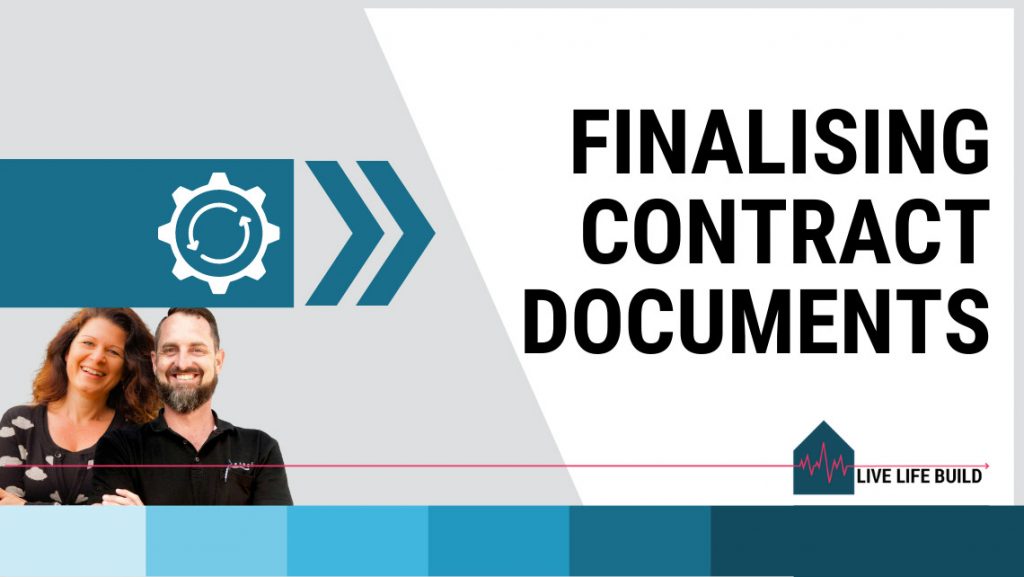How do you get it right when finalising your contract documents?
It’s an important process as a builder. Here’s how.
In this blog, we take you through the 5, 4, 3, 2, 1 of how to get it right when finalising your building contract documents, and ensure you’re not overlooking anything or making mistakes.
Builders often become builders because they love being outdoors, working physically and creating something with their own two hands. They love seeing their efforts create something real, and ending each day with visible progress for the work they’ve done.
Many builders also will say they weren’t great at school, they’re not academically inclined, and working on a computer can be frustrating for them (especially with that two finger typing technique).
And yet, so much about being a builder involves paperwork. Important paperwork that is legally binding, worth a lot of money, and can get you into serious trouble if you don’t do it properly.
We’ve seen builders struggle with this. They might be running their office from their dining table, or have a glove box or a diary stuffed full of paperwork. Or they keep shoving things in the direction of their wife or partner, asking them to deal with it because they can’t manage it AND building all day.
However, if you’re going to have a hope of growing your building business, and getting clients to trust and respect you, you need to get organised with your paperwork. Both electronic and hard copy.
It’s non-negotiable in protecting you and your business.
The building contract is probably the most important bit of paperwork in your projects. And finalising your building contract documents is an essential part of working with clients and getting started on building their new homes or renovations.
Want some help in how to get it right when finalising your contract documents?
Check out our 5, 4, 3, 2, 1 of our 6P Methodology PROCESSES: Finalising Your Contract Documents.
5. HAVE YOU READ YOUR CONTRACT IN DETAIL (INCLUDING THE DEFINITIONS)?
When Live Life Build was first beginning, we presented a workshop to a group of builders on behalf of James Hardie and Bretts Timber and Hardware.
Speaking to about 40 builders at this event, some of whom had been in business for decades, we asked this question:
“By a show of hands – how many of you have NOT read your contract in detail – from start to finish (including the definitions).”
Far too many builders put their hands up.
And you know what … we get it. The contracts we use when building and renovating people’s homes don’t make for engaging reading. They’re dry documents, full of a lot of legal jargon that can seem confusing.
And if it’s a standard document, then isn’t everyone operating by the same rules anyway, and so it should be that complicated, or open to much misunderstanding?
This is the thing though: your contract is your rule book for executing your projects, managing your clients, and fulfilling your legal obligations when building and renovating homes.
And so, it’s essential that you not only read it, but that you also understand what it means for your processes and practices. And that you explain to your clients what their obligations and responsibilities are inside the contract as well.
You know when big problems happen in projects? It’s when contract processes are handled informally – by both builders and homeowners. Very quickly, the parties involved end up in breach of contract, and it’s difficult to backtrack.
So, as boring as it may seem, sit down this afternoon and read through your contract. If you don’t understand specific items, tap into the many resources available online (and also most likely through the industry body you’re purchasing your contracts from) to learn more about what those items mean.
When finalising your contract with your clients, it’s great to ‘walk them through’ their building contract in detail. Our members will spend a couple of hours doing this with their clients as part of getting the contract signed.
Hang on … A couple of hours? Does that sound like overkill to you?
Well, it’s not. It actually does WONDERS for managing client expectations, setting the rules for how the project will be run, and getting everything out on the table at project commencement. It’s time very well spent to avoid dramas and headaches down the track.
And given the investment your clients are probably making in their future home, it’s a meeting worth doing properly and professionally so they feel comfortable and confident in legally committing to you and your business.

4. CREATE A CHECKLIST AND SYSTEM
There’s a general rule in business that, if you’re going to do something more than once, you should create a system for it.
And, as a builder, you’ll be finalising contracts before EVERY project you do. So, if you want to ensure you’re being efficient, doing it accurately each time, protecting yourself and your business, and operating professionally … then create a checklist and a system for this process.
Mentally rehearse the process of finalising a contract.
- What steps do you take each time?
- Do you get support with any of these steps from administrative staff or anyone else on your team?
- Are there steps that only you can do, and steps that you don’t actually need to do (but you’re doing at the moment because you haven’t taught anyone else how to do it)?
Even if you just jot these steps down on a piece of paper you stick on your office wall, you’re one step closer to streamlining your business.
Many builders hear ‘systems’ and their eyes glaze over. Or, they worry about the technology they need to use to document and share their systems, and let that get in the way of them ever creating the systems.
However, it can literally start as a simple checklist. This is something that will speed up the next time you have to finalise a contract, or even enable you to get help from someone on your team.
Trust us – in 3 months, you’ll have wished you started creating checklists and systems today. And the busier you are, the more essential checklists and systems become to help you avoid making mistakes or missing something.

3. WHAT ADDITIONAL DOCUMENTS AND PAPERWORK IS NEEDED?
Finalising a building contract is one part of the legal negotiations. However, there can be a range of additional documents and paperwork needed to resolve the contract, and formalise your agreement with your client.
This will include information such as the project documentation, and any specifications or selection schedules. And in certain locations and projects, it will also include a range of certificates from other consultants.
There may also be standard documents you get your clients to sign so you have written agreements with them prior to starting their project.
Some builders include photographic release documents at this point, so they’re able to share the client’s project progress on social media. (If you’re not doing this, start doing it – because getting the client’s ok to publicly share their project progress is an important step).
You may also need to get consent for electronic communications.
Getting your contract finalised with a client can involve A LOT of paperwork. Some of this is handled in hard copy, and some of it is handled digitally.
If you’re doing this by sending random emails back and forth, you may overwhelm your client.
Do you have a process for ensuring you’re not missing anything?
And do you do all of this in a way that helps your client feel you’re handling it professionally and methodically, so they feel confident in your organisational skills and professionalism?
One of the worst things you can do, at the beginning of your project with a client, (beyond missing something completely) is keep sending emails saying “Oh sorry, forgot I need to get you to sign this document. Please print it out, sign it, scan it, and send it back to me asap.”
Especially if you have tech-challenged clients who loathe dealing with electronic documents, or don’t have easy access to a printer or scanner, or just ignore your copious emails.
Consider how you can get all these documents signed and approved in a way that’s easier for you, less overwhelming for your client, and able to be executed as simply as possible. That way, you can finalise your contracts more quickly, and get on with the work of building.

2. GETTING IT SIGNED IS NOT ALWAYS THE LAST STEP IN CONTRACT FINALISATION
Depending on the contract you’re using, and the location you’re working in, there may be additional steps you need to take AFTER a contract is signed, in order to make it final.
This can involve the payment of levies and insurance to statutory bodies, and ensuring you have certificates to evidence the payment.
It can also involve you seeking proof of funding from your client (so you have confidence they can actually pay for your works before you dive in). And, if you’re doing a renovation project, it may also involve you seeking proof of their insurance of their existing home that’s not covered by your building contract / works insurance.
What steps, extra documents, payments and certificates are required by your contract, your local legislation and your governing industry body?
The process of contract finalisation can feel quite convoluted. Sometimes it feels like things should happen in a different order, and that contract signing should be the very last step. But in some locations and for some contracts, signing the contract needs to happen first before final certificates can be sought and insurances paid.
Know, in detail, what’s involved for each contract you’re using. You’ll most likely find that if you don’t follow this to the letter of the law, the contract you’re using has not been properly executed, and will not be a proper agreement as a result.
Be sure to factor in time into your project preparation to do this properly. Educate your clients about what steps are involved, and what their responsibilities are. If you know it’ll take time for them to pull together paperwork, give them good warning.
For example, if they need to get a letter from their bank manager about their availability of funds (which can be a confronting conversation to have with them initially), don’t spring it on them.
The more you guide and support your client through this process, and the more informed they feel, the easier it will be for you to get all the relevant information together as needed.

1. CHECKING ALL IS CORRECT AND FILING FOR YOUR RECORDS
Once your contract is signed, and all associated documents and paperwork are also contractually referred to (plus initialled and included), and all required payments made, then finish the process properly.
This is not the time to get casual about your paperwork. All these documents are a legally binding relationship between you and your client. Ensure you file them properly for your records.
They say the best contracts are ones that are thoroughly reviewed at the time of negotiation and signing, and then put away in a drawer and never looked at again!
However, your building contract will probably not be like that.
In fact, more often than not, there will be changes or unexpected occurrences on site. And this is when you’ll need to refer back to those agreed, legally binding documents, to identify the quantity and type of changes, and what’s contractually involved.
One area that homeowners can really struggle with (and builders) is variations.
Variations to cost and time can be a huge source of concern and dispute in projects. Often builders handle them casually, especially early in the project, as they try to establish good relations with their clients. They let the first few go, absorb the extra cost and time, in an effort to build camaraderie with their clients.
Then builders wonder, when they do actually go to charge for them later in the build, they get all sorts of resistance and complaints from their clients.
Don’t do this.
If there are variations, execute them according to your contract right from the start of the project. The contract enables you to do this, and if you’ve properly educated your client, they’ll be prepared for it when it happens.
This manages expectations in the project, avoids dramas and misunderstandings, and also means you’re behaving like a professional builder who respects the legal agreement you have with your client.
So, file your contract and all associated documents for your records – and then keep referring back to them throughout your project, so you can show variations to the original agreement, and keep your clients informed (and totally across the changes that are occurring).
At Life Life Build, we’re passionate about elevating professionalism in the residential construction industry. We want builders to be respected for their expertise and experience, and their businesses to be seen as professional operations.
When you handle things casually in your projects, you cloud the relationship with your clients. You teach them that they’re dealing with a person, not a business. It can get messy very quickly.
Builders then complain when clients take liberties with them (like calling after hours, or expecting them to meet up on the weekend), but you can’t be surprised when this is the standard you set.
Instead, be professional. Behave professionally. Set professional expectations and standards for your business.
Finalise your contract properly. Then follow the contract. Keep things on track to the contract. Refer to it as your rule book for project execution.

So, here’s our 5, 4, 3, 2, 1 to identify your ideal project.
5. Have you asked your team what their goals are?
4. How can you help and facilitate your team’s goals?
3. What are your goals as a team?
2. Holding people accountable.
1. Celebrate the wins and create a good work environment.
Live Life Build’s 6P Methodology unlocks the 6 ways to elevate your building business:
PERSONAL | PROJECTS | PEOPLE | PARTNERSHIPS | PROCESSES | PROFESSIONAL
Do you have a process for finalising your contract?

